The Role of Nymphs in the Myths of Odysseus and the Odyssey
I. Introduction
The “Odyssey,” attributed to the ancient Greek poet Homer, is one of the foundational epics of Western literature. It narrates the adventurous journey of Odysseus as he attempts to return home to Ithaca after the Trojan War. Within this epic, nymphs play a crucial role, influencing Odysseus’s path and shaping his experiences. This article aims to explore the significance of nymphs in the “Odyssey” and how they contribute to Odysseus’s journey.
II. Understanding Nymphs in Greek Mythology
Nymphs are divine spirits in Greek mythology, often associated with various natural elements. They embody the beauty and vitality of nature and are typically represented as young, attractive female figures. There are several types of nymphs, including:
- Naiads: Nymphs of freshwater, such as rivers and springs.
- Dryads: Tree nymphs, specifically associated with oak trees.
- Oceanids: Nymphs of the ocean, often depicted as daughters of the sea god Oceanus.
Nymphs symbolize the connection between humanity and the natural world, representing divine femininity and the nurturing aspects of nature. In ancient Greek culture, they were often seen as both protectors and seducers, embodying the duality of attraction and danger.
III. Key Nymphs Encountered by Odysseus
A. Calypso: The Enchantress of Ogygia
Calypso is one of the most prominent nymphs in the “Odyssey.” She lives on the island of Ogygia, where she detains Odysseus for several years, offering him immortality and eternal youth. Her role in the epic is multifaceted:
- She represents the theme of love, as she falls deeply in love with Odysseus and desires to keep him forever.
- Calypso embodies captivity and choice; Odysseus is torn between his love for her and his longing for home.
This encounter highlights the tension between desire and duty, illustrating how Calypso’s affection complicates Odysseus’s journey.
B. Nausicaa: The Princess of Phaeacia
Nausicaa is another significant nymph Odysseus encounters. She is the daughter of King Alcinous and Queen Arete of Phaeacia and plays a crucial role in aiding Odysseus:
- Her introduction marks a turning point in Odysseus’s journey, as she provides him with hospitality and assistance, ultimately leading him to safety.
- Nausicaa represents themes of youth and innocence, as well as the virtues of hospitality and kindness.
Their interactions showcase the positive aspects of Odysseus’s encounters with nymphs, emphasizing the importance of compassion and support in his journey.
IV. The Influence of Nymphs on Odysseus’s Character Development
Odysseus’s encounters with nymphs significantly shape his character throughout the “Odyssey.” These interactions contribute to his identity in several ways:
- They challenge his resolve and test his desires, forcing him to confront the tension between personal longing and his responsibilities as a husband and leader.
- The duality of his experiences with nymphs—captivity with Calypso versus the kindness of Nausicaa—highlights his growth as a hero who learns to navigate complex human emotions.
In essence, the nymphs serve as catalysts for Odysseus’s transformation, pushing him toward a deeper understanding of himself and his place in the world.
V. Thematic Elements Associated with Nymphs
The presence of nymphs in the “Odyssey” introduces several thematic elements that resonate throughout the epic:
- Interplay of Fate and Free Will: Odysseus’s choices regarding the nymphs reflect the broader theme of fate versus free will in the epic, as he grapples with predestined outcomes and personal desires.
- Temptation and Consequences: The allure of nymphs represents the temptations that Odysseus faces, illustrating how these encounters have significant consequences on his journey.
- Feminine Power and Autonomy: Nymphs are depicted with agency, showcasing their strength and influence over Odysseus, which challenges traditional gender roles in ancient Greek society.
VI. Nymphs as Guardians of the Natural World
Nymphs are intrinsically linked to the natural world, serving as its guardians:
- They symbolize the beauty and peril of nature, embodying the wilderness that Odysseus must navigate.
- The natural elements they represent are crucial to Odysseus’s journey, as he frequently finds himself in wilderness settings where nymphs play protective roles.
By acting as guides and protectors, nymphs enhance the theme of nature as both a nurturing and challenging force in Odysseus’s adventures.
VII. Comparative Analysis of Nymphs in Other Myths
When examining nymphs across different myths, several similarities and differences emerge:
- In various myths, nymphs often serve as both helpers and hindrances to heroes, reflecting their dual nature.
- Unlike more malevolent figures, nymphs in the “Odyssey” primarily exhibit benevolence, emphasizing their role as protectors.
- Other divine beings, such as gods and goddesses, interact with nymphs, highlighting a complex hierarchy of power and influence in Greek mythology.
This comparative analysis sheds light on cultural reflections of femininity and the natural world, showcasing nymphs as integral figures in mythological narratives.
VIII. Conclusion
In the “Odyssey,” nymphs play pivotal roles that significantly impact Odysseus’s journey and character development. They symbolize the complexities of desire, the interplay of fate and free will, and the guardianship of nature. Through figures like Calypso and Nausicaa, the epic conveys timeless themes of love, temptation, and the strength of femininity. The lasting impact of nymphs in the “Odyssey” not only enriches the narrative but also offers profound insights into human nature and the world around us.




